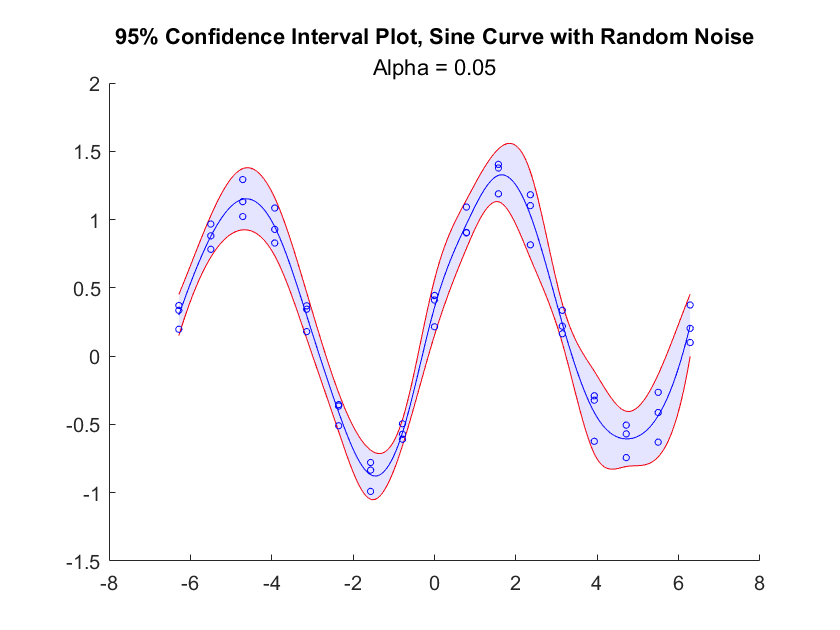Confidence Interval Plot
Versione 1.0 (169 KB) da
Benjamin Kraus
Creates a chart with a mean line within a shaded confidence interval area.
Confidence Interval Plot
Version: 1.0
This chart creates a mean line within a shaded confidence interval area.
Syntax
-
confidenceIntervalPlot(x,y)create a line which passes through the means of the y-values for each unique x-value. Plot this line within a shaded area covering a 95% confidence interval for each unique x-value. x and y must be numeric vectors of equal length. -
confidenceIntervalPlot(x,y,alpha)create a line which passes through the means of the y-values for each unique x-value. Plot this line within a shaded area covering a 100 * (1 - alpha)% confidence interval for each unique x-value. x and y must be numeric vectors of equal length. -
confidenceIntervalPlot()create an empty confidence interval plot. -
confidenceIntervalPlot(___,Name,Value)specifies additional options for the confidence interval plot using one or more name-value pair arguments. Specify the options after all other input arguments. -
confidenceIntervalPlot(parent,___)creates the confidence interval plot in the specified parent. -
h = confidenceIntervalPlot(___)returns the confidenceIntervalPlot object. Use h to modify properties of the plot after creating it.
Name-Value Pair Arguments/Properties
-
XData(1 x n numeric vector) x-values of the raw data. -
YData(1 x n numeric vector) y-values of the raw data. -
CenterXData(1 x n numeric vector) read-only property. x-values used to plot the center line. Unless the name/value pair'edges'is used, contains unique x-values in XData. -
CenterYData(1 x n numeric vector) y-values used to plot the center line. Unless the name/value pair'edges'is used or CenterYData is manually specified by the user, contains the mean of y-values for each unique x-value in XData. -
CenterYDataMode('auto'or 'manual') mode describing the method by which the center line is determined. In'auto'mode, the mean of the y-values for each center line x-value used. In'manual'mode, the user can specify CenterYData as Name/Value pair. -
Alpha(scalar double) confidence level (denoted alpha) for the confidence interval about the mean line. Has lower precedence than UpperBoundData and LowerBoundData if specified. -
UpperBoundData(1 x n numeric vector) upper bound data of the shaded area encapsulating the mean line. By default is set to MeanData + StdDevData unless otherwise specified. -
LowerBoundData(1 x n numeric vector) The lower bound data of the shaded area encapsulating the mean line. By default is set to MeanData - StdDevData unless otherwise specified. -
BoundDataMode('auto'or 'manual') mode describing the method by which the bounds of the shaded area are determined. In'auto'mode, a confidence interval of level alpha (default0.05) will be used. In'manual'mode, the user can specify UpperBoundData and LowerBoundData as Name/Value pairs. -
Edges(1 x n numeric vector) edges of the bins used to group raw x-data values and generate the center line x-data and y-data. Once grouped, the mean x-value of each bin (excluding NaNs) will be used for CenterXData and the mean y-value of each bin (excluding NaNs) will be used for CenterYData.
Stylistic Name-Value Pair Arguments/Properties
-
TitleText(1 x n char vector) title of the confidence interval plot. -
SubtitleTextn x 1 char vector) subtitle of the confidence interval plot. -
ShadeColor(1 x 3 numeric vector) color of the shaded area surrounding the mean line. -
ShadeAlpha(scalar double) transparency (alpha) of the shaded area surrounding the line. -
CenterLineColor(1 x 3 numeric vector) color of the center line contained in the shaded area. -
CenterLineWidth(scalar double) width of the center line. -
BorderLinesColor(1 x 3 numeric vector) color of the two lines outlining the shaded area from above and below. -
BorderLinesWidth(scalar double) width of the two lines outlining the shaded area about the center line. -
ShowRawData(scalarmatlab.lang.OnOffSwitchState) OnOffSwitchState object indicating whether to plot the original data (XData, YData) as scatter points. -
RawDataMarker(char) marker symbol for raw data if ShowRawData is true. -
RawDataMarkerColor(1 x 3 numeric vector) color of data markers for raw data if ShowRawData is true. -
RawDataMarkerSize(double) size of data markers for raw data if ShowRawData is true. -
ShowCenterData(scalarmatlab.lang.OnOffSwitchState) OnOffSwitchState object indicating whether to plot the original data (CenterXData, CenterYData) as scatter points. -
CenterDataMarker(char) marker symbol for raw data if ShowCenterData is true. -
CenterDataMarkerColor(1 x 3 numeric vector) color of data markers for raw data if ShowCenterData is true. -
CenterDataMarkerSize(double) size of data markers for raw data if ShowCenterData is true.
Example
Create a confidence interval plot for sine data with noise. Each unique x-value is associated with three y-values. By default, the confidence interval is a 95% confidence interval for each unique x-value.
uniqueX = -2 * pi : pi/4 : 2*pi;
x = repelem(uniqueX, 3);
y = sin(x) + 0.5 * rand(size(x));
cip = confidenceIntervalPlot(x,y);
cip.NumSteps = 10;
title("95% Confidence Interval Plot, Sine Curve with Random Noise");
subtitle("Alpha = 0.05");
Cita come
Benjamin Kraus (2024). Confidence Interval Plot (https://github.com/MATLAB-Graphics-and-App-Building/confidenceIntervalPlot/releases/tag/v1.0), GitHub. Recuperato .
Compatibilità della release di MATLAB
Creato con
R2021a
Compatibile con R2021a
Compatibilità della piattaforma
Windows macOS LinuxCategorie
- MATLAB > Graphics > 2-D and 3-D Plots > Line Plots > Errorbars >
- MATLAB > Graphics > Graphics Objects > Developing Chart Classes >
Scopri di più su Errorbars in Help Center e MATLAB Answers
Tag
Community Treasure Hunt
Find the treasures in MATLAB Central and discover how the community can help you!
Start Hunting!Scopri Live Editor
Crea script con codice, output e testo formattato in un unico documento eseguibile.
| Versione | Pubblicato | Note della release | |
|---|---|---|---|
| 1.0 |
Per visualizzare o segnalare problemi su questo componente aggiuntivo di GitHub, visita GitHub Repository.
Per visualizzare o segnalare problemi su questo componente aggiuntivo di GitHub, visita GitHub Repository.




